|
|
|
Sort Order |
|
|
|
Items / Page
|
|
|
|
|
|
|
| Srl | Item |
| 1 |
ID:
139679
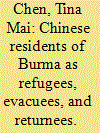

|
|
|
|
|
| Summary/Abstract |
This article analyses how, at the time of the Japanese military expansion across Asia in the 1930s and 1940s, the category of ‘Burma Chinese’ and notions of ‘Chineseness’ acquired meaning through the movement across Chinese and Indian borders of residents of Burma identified as Chinese. Focusing on the terminology utilized by various reporting organizations to refer to evacuees, refugees or returnees, this article asks what we can learn from bureaucratic exchanges and practices of documentation about the wartime migration of Burma Chinese. I argue that a shared racial logic of territorialization operates across divergent sets of correspondence concerned with the repatriation of Burma Chinese to Burma. Multiple acts of iteration and practical implementation of categories naturalized this racial logic with respect to Burma Chinese in the latter half of the 1940s. Understanding how the work of repatriating Burma Chinese rested upon a shared racial logic is important because the regulation of Asian wartime migration was foundational to the emerging international refugee regime and post-Second World War world order.
|
|
|
|
|
|
|
|
|
|
|
|
|
|
|
|
| 2 |
ID:
139676
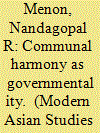

|
|
|
|
|
| Summary/Abstract |
Debates about secularism in post-independence India have often revolved around the visions of two of the country’s founding fathers—M.K.Gandhi and Jawaharlal Nehru. A sharp distinction is drawn between them by those who argue that the Gandhian model (or, what in common parlance and state discourses is called communal harmony) stems from Indian cultural and religious values, and lies beyond the realm of the state. The Nehruvian model, however, is a state project through and through. This article transcends this dichotomy to show that
the association of Nehru and Gandhi with these models does not necessarily mean that secularism and communal harmony faithfully reflect their ideas and, despite the differences in their aims and methods, both models are united in the discourses and practices of the state as strategies of ‘governmentality’. After redefining the core of communal harmony as reciprocity (rather than tolerance), I show how it is performed, how it supplements the state’s efforts to keep the peace in a religiously plural society by the force of law, and shores up the state’s
legitimacy deficit. However, the state’s simultaneous involvement in Nehruvian and Gandhian projects is not an innocuous fact because it undermines the state’s constitutional and secular obligations to non-discriminatory citizenship in the Indian nation. The argument is that the state’s endorsement of dargah-centred Islamic piety as an exemplary site of communal harmony and particular ideas of the Indian nation legitimized by communal harmony ‘problematizes’ the national belonging of certain kinds of pious Muslims.
|
|
|
|
|
|
|
|
|
|
|
|
|
|
|
|
| 3 |
ID:
139671


|
|
|
|
|
| Summary/Abstract |
This article examines the way in which legal codification, the scrutiny of the high courts, and the expansion of the ‘native Bar’ restructured colonial ‘preventive policing’. Habitual Offender legislation in England targeted the ex-convict, but in India the bad-livelihood sections of the Code of Criminal Procedure (CrPC sections 109–110) permitted a far more flexible construction of ‘habituality’. They illustrate the degree to which summary judicial powers wielded by the executive head of the district were incorporated into the code, not excised from it. Educated Indians critiqued this combination of executive and judicial powers in the hands of the district magistrate, yet CrPC ‘preventive sections’ proliferated. Furthermore, in 1918 the Punjab province passed a Habitual Offender Act which, drawing upon the pattern of the Criminal Tribes Act (Act XXVII of 1871), permitted CrPC section 110 to be used to restrict the suspected ‘habitual’ to a certain area as well. Hitherto amendments to the CrPC were supposed to be matters for central not provincial legislation. The Punjab Act inaugurated an era of provincial enactments to intern or release ‘habituals’, structured around essentialist contrasts between urban and rural space. Under the surface of drives to codify colonial law a striated jurisdictional topography continued to re-form.
|
|
|
|
|
|
|
|
|
|
|
|
|
|
|
|
| 4 |
ID:
139677


|
|
|
|
|
| Summary/Abstract |
To what extent are different parts of the world exceptional when it comes to the history of forced migration and refugee experiences? For instance, is forced migration in Asia distinct from developments elsewhere? Or is forced migration in Asia part of wider processes of displacement and emplacement so characteristic of the modern world? Over the past few decades, the fields of refugee and forced migration studies have ballooned. Scholars in a wide range of disciplines,
including anthropology, political science, geography, and history have sought to understand the nature of population displacements in the modern world. Much of the early scholarship in this field focused on Europe in the immediate aftermath of the First and Second World Wars. Scholars have also sought to understand the nature of protracted refugee situations in Africa.More recently, scholars have investigated forced migration within globalized and transnational frameworks.
|
|
|
|
|
|
|
|
|
|
|
|
|
|
|
|
| 5 |
ID:
139673
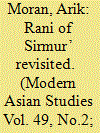

|
|
|
|
|
| Summary/Abstract |
In ‘The Rani of Sirmur: An Essay in Reading the Archives’, Gayatri Chakravorty Spivak offered a literary analysis of British records to demonstrate the inextricability of language from the colonial/imperial project’s goal of world domination. Honing her arguments on the threat of a Himalayan queen (rani) to ‘become sati’ (i.e. immolate herself), Spivak interpreted the event as
representative of the plight of subalterns and of ‘third world women’ in particular. However, a close reading of the records reveals profound discrepancies between Spivak’s interpretation and conditions that existed in and around the kingdom at the time. This article contextualizes the rani’s story by supplementing archival sources with folk traditions, local histories, and recent research on sati and Rajput women. It shows that the rani was actually an astute ruler, similar to her peers in the West Himalayan elite, and that her threat of suicide resulted from reasons
that go beyond an alleged attempt at recovering agency from the dual oppressions of patriarchal indignity and an invasive superpower. The discourses about sati in contemporary texts are also investigated, revealing a considerable overlap in South Asian and European views of sati among Himalayan elites in turn-of-thenineteenth-century northwest India.
|
|
|
|
|
|
|
|
|
|
|
|
|
|
|
|
| 6 |
ID:
139675
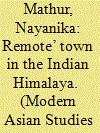

|
|
|
|
|
| Summary/Abstract |
This article studies the impact of the creation of a new state in northern India through an analysis of space. The space under consideration is the town of Gopeshwar, which serves as the administrative headquarters of a district in the state of Uttarakhand. Uttarakhand was created as a distinct Himalayan state in 2000 after a prolonged period of mass agitation to this end. The movement for statehood had emphasized historical neglect coupled with exploitation of
the mountains of Uttarakhand by the plains. Beginning with an analysis of the town plan, this article moves on to describe how this place is made into a space by everyday practices. In particular it concentrates on the narratives of agents of the state who express a longing to escape this ‘remote’ town. Through an interrogation of the trope of remoteness, this article argues that the creation of the new state has served, ironically enough, to accentuate the traditional characterization of the Himalaya as a backward, inferior space within India.
|
|
|
|
|
|
|
|
|
|
|
|
|
|
|
|
| 7 |
ID:
139672


|
|
|
|
|
| Summary/Abstract |
This article presents new evidence with which to evaluate the validity of the popular picture of religious environmentalism in India. It examines accounts of a large number of incidents described in Indian language newspapers, the colonial archive, and hunting literature published between the 1870s and 1940s, in which British and other sportsmen clashed with villagers in India while out hunting. During the late nineteenth and early twentieth centuries, the colonial sports-hunting obsession was in its heyday, but opposition to hunting across India was also mounting. Rural villagers, in particular, were often willing to become involved in physical combat with hunters, apparently in order to protect local wildlife. Sportsmen often assumed that it was religious fanaticism that made Hindus defend the lives of what they saw as game animals, trophies, and specimens. The article provides evidence that, in addition to religion, amixture of other motivations explains Hindu interest in the conservation of certain species. Anti-colonial consciousness, assertions of local authority and territoriality, and an environmental ethic can all be identified as being at work. The end result was the increased conservation of certain species of wildlife.
|
|
|
|
|
|
|
|
|
|
|
|
|
|
|
|
| 8 |
ID:
139682
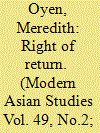

|
|
|
|
|
| Summary/Abstract |
This article examines the rise of the international refugee regime in Asia, focusing on the work of the International Refugee Organization in repatriating overseas Chinese from mainland China back to their homes in Southeast Asia from 1947 to 1956. It looks both at how the International Refugee Organization inherited this repatriation project from its predecessor—the United Nations Relief and Rehabilitation Administration—and its survival after a civil war installed a new, Communist government on the Chinese mainland. Doing so reveals the extent to which both Chinese governments had to rely on outside assistance to fulfil an important task of maintaining positive ties between Chinese abroad and the homeland. Using research from the Ministry of Foreign Affairs archives in Beijing and Taipei, as well as records from relevant parties in the British and American governments, this article places the repatriation programme and the larger efforts of the International Refugee Organization in Asia in a broader context of regional foreign relations and the origins of the Cold War.
|
|
|
|
|
|
|
|
|
|
|
|
|
|
|
|
| 9 |
ID:
139674
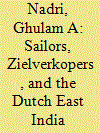

|
|
|
|
|
| Summary/Abstract |
In the second half of the eighteenth century, the Dutch East India Company (VOC) employed hundreds of Indian sailors in Surat in western India to man its ships plying the Asian waters. The Moorse zeevarenden (Muslim sailors) performed a variety of tasks on board ships and in the port of Batavia, and made it possible for the Company to carry out its commercial ventures across the Indian Ocean. The relationship between the two, however, was rather complex and even contentious. Based on Dutch sources, this article investigates the political-economic contexts of this relationship, examines the structure and organization of the maritime labour market in Surat, and illuminates the role and significance of zielverkopers (labour contractors) and of the local administration. The analysis of the social, economic, and familial aspects of the market and labour relations in Surat sheds light on pre-capitalist forms of labour recruitment and the institutional dynamics of the Indian labour market.
|
|
|
|
|
|
|
|
|
|
|
|
|
|
|
|
| 10 |
ID:
139678
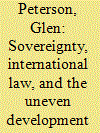

|
|
|
|
|
| Summary/Abstract |
When we think about the history of the international refugee regime, why is it that—with a few carefully delineated exceptions—there were no non-European ‘refugees’ until the 1950s? This article offers a critical examination of existing scholarship on the history of the international refugee regime and suggests some alternative pathways for future research. The article has three broad objectives. The first is to propose an outline for an alternative history of the international refugee regime, one in which the non-European and colonial worlds are not invisible or peripheral but rather central to the main narrative. The second is to ask what place Chinese migrants might occupy in such an alternative history of human displacement, stretching over the course of the twentieth century. Finally, this article tries to show that the period from 1945 to the early 1960s was an especially critical one in the history of the international refugee regime, one in which refugee movements both out of and into the People's Republic of China were critical in generating the kinds of tensions and contradictions that emerged when the international refugee regime was transposed from Europe onto colonial and post-colonial Asia.
|
|
|
|
|
|
|
|
|
|
|
|
|
|
|
|
| 11 |
ID:
139680
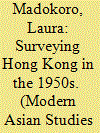

|
|
|
|
|
| Summary/Abstract |
At the end of the Second World War, there were over a million displaced persons and refugees in Europe alone. Hundreds of thousands of people were uprooted with the expansion of the Japanese empire across the Pacific Theater, and many others were similarly displaced when Japan was defeated. Others later fled civil conflicts, in South Asia, for instance, and in China, where thousands left the mainland during the final days of the Chinese Civil War. Among this massive displacement in Asia, unlike in Europe, only a few groups were identified as refugees. One such group consisted of the migrants in Hong Kong who, after 1949, were understood to be refugees fleeing communist oppression in the People's Republic of China. This article examines the critical role that surveys (population studies designed to account for, and define, refugee groups) played in shaping particular, Westernized Cold War understandings of the refugee experience in Hong Kong. These surveys were organized by non-state interests and undertaken with financial support from major American philanthropies. In examining the objectives and methodologies of the refugee surveys conducted in Hong Kong in the early 1950s, in contrast with studies undertaken contemporaneously in Europe, this article observes that, although at the time the flaws in the surveys were recognized and regularly disregarded in the pursuit of broad political objectives, scholars have failed to adequately recognize the subjective nature of the surveys' supposedly empirical evidence. As a result, the dominant European-based narrative about modern refugees has obfuscated the distinctive aspects of the refugee experience in Hong Kong.
|
|
|
|
|
|
|
|
|
|
|
|
|
|
|
|
| 12 |
ID:
139681
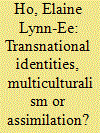

|
|
|
|
|
| Summary/Abstract |
This article investigates the tensions that emerge when transnational identities are juxtaposed against claims of multiculturalism and de facto assimilation processes. The article focuses on the resettlement of co-ethnics who arrived in China through forced migration between 1949 and 1979 and the generational transitions of their descendants. The Chinese state resettled these forced migrants from Southeast Asia on state-owned farms known as the ‘overseas Chinese farms’ and gave them preferential treatment as ‘returnees’ rather than ‘refugees’. They retained transnational cultural identities which set them apart from the China-born Chinese and suffered further stigmatization during the Cultural Revolution. This article highlights the limitations of using ethnicity as a lens for understanding how ‘difference’ is negotiated in China. In contemporary times the (multi)cultural identities of the refugee-returnees are promoted for the purposes of tourism to help reinvent the farms for economic sustainability. Yet the identity transitions experienced by the children and grandchildren of the refugee-returnees suggest that they are assimilating a national identity that subsumes their overseas Chinese cultures, serving to normalize a Chinese identity associated with the locally born Chinese instead. The article argues that the objectification of overseas Chinese heritage and assimilation ideology work together to selectively highlight China's historical connections to its co-ethnics abroad while simultaneously projecting a new national narrative of contemporary Chinese identity that is distinct from the overseas Chinese. This article on Chinese forced migration and resettlement provides useful insights concerning the negotiation of transnational identity with respect to multiculturalism and assimilation, and further suggests new directions for overseas Chinese studies today.
|
|
|
|
|
|
|
|
|
|
|
|
|
|
|
|
|
|
|
|
|